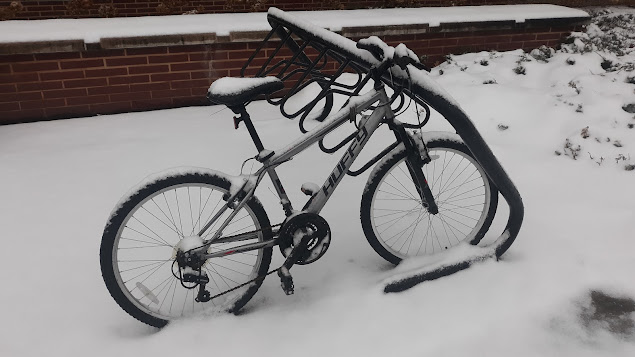Bicycles and Icicles: Seven Tips for Riding in Winter
Written by Anne Johnson
1. Go Slow in the Snow
Winter riding often has many more challenges than other times of the year, with snow blocking paths and ice making things slippery. This means it’s very important to go carefully - go slow to give plenty of time to spot unexpected obstacles and be sure to leave more time and distance for braking.
2. Keep Your Clothing Warm and Bright
Things can get quite cold during the winter, so be sure to dress appropriately. Wearing layers can help you adjust if biking warms you up or weather conditions change, and having a waterproof layer on top is always a good idea. It is also important to protect your extremities, so warm socks, gloves/mittens, and face protection are a must. Bright colored clothing and bike lights will make you more visible to others and wearing ski goggles or sunglasses will help you see better when there is glare off snow and ice.
3. Wintertime Washing
During the winter, the constant presence of salt and water will make it very easy for your bike to rust. Be sure to keep it clean by wiping off snow and slush and lubricating your chain and gears on a regular basis. We used to add a thin coat of car wax to our bikes in the fall to help prevent rust and keep snow from sticking to our bikes, so if you have some lying around feel free to apply it to the frame of your bike for a bit more protection from the elements. If you have the space, storing your bike indoors or in a sheltered location can also keep it clean and in better condition.
4. Making Things Low Pressure
Lowering your tire pressure a little bit will increase the surface area of the tire touching the road and thus give you a bit more traction in the winter, so many will do this (especially if using unmaintained routes). However, keep in mind that temperature affects pressure with colder temperatures resulting in lower pressure, so be sure to keep an eye on it so it doesn’t get too low, or, if you bring your bike somewhere warm, too high.
5. Watch the Weather
Weather can change quickly, so do your best to be prepared for a variety of conditions. Knowing of alternative transit options along your route, such as bus stops, is important in case things get too bad to ride - and know where this limit is for you. Also, be careful of black ice - if the path looks wet and it is below freezing, there’s a good chance this is ice even if the route has been salted, as road salt stops being effective below 15 to 20°F.
6. Know Where to Go
Plan your route before you go, and try to stick to maintained paths. You can find the Bike Facilities Winter Maintenance Map released by the Centre Regional Planning Agency here to help you plan. When biking in the streets, remember that drivers may have a difficult time seeing you due to precipitation and glare off of snow and ice, so dressing for visibility and riding defensively are important. Also, sticking to back streets where there is less car traffic is often a good idea, even if they are not as well maintained.
7. Falling is a Part of Learning
If you are just starting winter biking, there is a good chance you’ll fall - I certainly did when I started! There are many ways to prepare for this, including making sure you are wearing your helmet and perhaps adding knee and elbow pads. Wear shoes that have good traction, but don’t strap your feet to your pedals so you can catch yourself if you begin to tip. Lowering your seat a bit can also make it easier to catch yourself and evenly distributing your weight on the bike can give you better balance.




Comments
Post a Comment